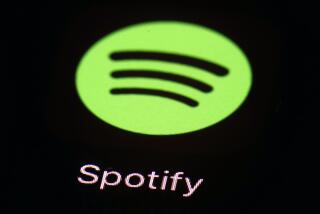YouTube brings its huge fan base to music streaming

The music industryâs move toward paid subscription services, and away from discs and downloads, has been underway for several years.
On Wednesday, YouTube joined the party â bringing with it the worldâs largest audience for popular music and the financial clout of its parent company, Google Inc.
The video streaming company announced plans to launch a service dubbed YouTube Music Key that will give users access to tens of millions of songs, for about $10 a month.
The move underlined the shift toward streamed services as the music industryâs future. Also Wednesday, concert promoter Live Nation announced a partnership with Vice to launch a music-themed video service for mobile phones, TV and Internet.
There is already fierce competition in this space from streaming services including Spotify, Rhapsody and Pandora. Still, YouTubeâs reach with consumers makes it a powerful contender out of the gate.
âTheyâre sort of already the 800-pound gorilla,â said Ben Bajarin, an analyst at Creative Strategies. âTheyâve already got a big base.â
Not everyone is signing on, however. Irving Azoff, the music industry veteran who has formed a new company called Global Music Rights to manage royalties for artists, says his 41 clients â including Pharrell Williams, Smokey Robinson and the estate of John Lennon â may not participate.
Azoff, the former chairman of Live Nation, said YouTube isnât paying his clients enough. He wants to help bring an end to a âhistory of undeniably lowâ payments to songwriters for their work.
âThe trampling of writersâ rights in the digital marketplace without any regard to their contribution to the creative process will no longer be tolerated,â Azoff said.
YouTube did not immediately respond to Azoff.
Their new on-demand offering will allow subscribers to listen to music and watch videos without commercials. Users will be able to listen on their smartphones while sending text messages and store videos and music on their devices for offline listening.
âWe want YouTube to continue to be the best place for artists and fans to connect,â said Christophe Muller, the companyâs head of music partnerships, and âgive artists more ways to connect with fans and earn more revenue.â
The pros and cons of music streaming services have been debated for years, and even popular Swedish service Spotify had its U.S. launched delayed multiple times as rights negotiations dragged on. The debate has become even more heated in recent weeks.
Taylor Swift recently joined a growing roster of musicians who have complained about the fractions of a cent that Spotify pays artists each time a consumer streams a song. Four days after her new album, â1989,â was released, Swift and her Nashville-based label Big Machine Records withdrew all her music from the streaming service.
Jimmy Buffett recently went public asking Spotify founder Daniel Ek for a raise, and other musicians including Beyonce, Coldplay, the Black Keys and Radiohead leader Thom Yorke have chosen to withhold their music from the service. Yorke collaborator and producer Nigel Godrich wrote on Twitter that artists âare scared to speak up or not take part as they are told they will lose invaluable exposure if they donât play ball.â
Spotify founder Daniel Ek, for his part, has argued that the serviceâs 12.5 million paid subscribers worldwide are spending $120 on music per year, more than âthree timesâ than the average paying music consumer. Swift, before she pulled her catalog, wrote Ek, was on track to receive a $6-million payout this year.
YouTube holds a complicated position in the music industry. Though it is seen as a critical promotional tool for labels and musicians, record companies also want to be able to better monetize their big online audience.
The video site is now one of the main ways new artists get discovered and established players get the word out about new music. Official videos by artists such as Miley Cyrus (âWrecking Ballâ) and Meghan Trainor (âAll About That Bassâ) have amassed hundreds of millions of views, and videos have helped propel the likes of Justin Bieber, Psy and Baauer to worldwide fame.
Two years ago, Swift even debuted her song âNever Getting Back Togetherâ before it hit radio airwaves. And itâs not just professional musicians. Countless numbers of people have uploaded their own versions and parodies of Gotyeâs âSomebody That I Used to Knowâ and âLet It Goâ from Disneyâs âFrozen.â
Now Music Key is going down the path the likes of Spotify and Rhapsody have already charted, by charging users for access.
Itâs starting off with a promotional monthly fee of $7.99, $2 lower than most rivals. Those invited at launch will have free use for six months after it debuts early next week.
YouTube says people around the world watch more than 6 billion hours of its videos a month. The question now is whether it can get a substantial portion of that huge audience into subscribers, and also be able to tap new users who use Googleâs Android operating system on their mobile phones.
âThere has to be a legitimate business model that makes it worth it to produce quality content,â said Bajarin. âThis is a step in the right direction, which is to convert people who are already using it for free.â
YouTube has secured the rights to a huge catalog of songs with deals with three major record labels, Universal Music Group, Sony Music Entertainment and Warner Music Group. The tech giant also has deals with hundreds of independent music companies.
Not all those deals came easily. The service has been rumored for more than a year, but the rollout was said to be delayed by negotiations with independent labels, which complained that YouTube had offered unfair terms.
However, YouTube and Merlin, a rights organization for indie labels and artists, were able to come to an agreement, according to the Financial Times.
YouTube monetizes its free videos by placing advertising on them, and whoever owns the rights gets a piece of that revenue.
The company also uses a technology called Content ID that finds videos that use copyrighted music, so that the owners can either ask to have the videos taken down or make money from them by getting ads placed.
Listeners have benefited by getting the music for free. The question now is whether they will opt to actually pay for it.
Paul Verna, a senior analyst at eMarketer, said that will be a challenge for Google because users have become accustomed to waiting through short ads to get to the tunes.
âItâs been a free-for-all from Day One,â Verna said. âAn ad-free experience doesnât seem as compelling or attractive on YouTube.â
Follow me on Twitter: @rfaughnder
Follow me on Twitter:@Toddmartens
More to Read
From the Oscars to the Emmys.
Get the Envelope newsletter for exclusive awards season coverage, behind-the-scenes stories from the Envelope podcast and columnist Glenn Whippâs must-read analysis.
You may occasionally receive promotional content from the Los Angeles Times.












